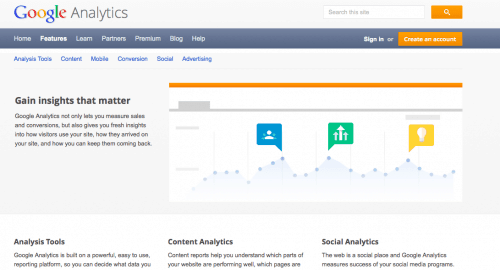What gets measured gets improved. There’s a reason why data is a hot topic right now and it’s because data is a valuable source of identifying how people behave and making educated improvements to your online business. Facebook’s business model is based on user data, Netflix tracks what movies you like and recommends new ones and similarly Amazon helps you discover new items to buys.
So when it comes to your business, one of the first things every website gets fitted with is Google Analytics. Another free product from the search giant, which helps you track the performance of your website.
It’s also extremely easy to get started. Simply sign into your Google account and head over to Analytics. What you’ll need to do is go to the Admin panel and click “Add account”. From there on in you just fill in some very basic information about your website to receive your Tracking ID. After that you’re ready to install your tracking code.
Afterwards you can also connect Google Analytics to your Cuutio account. Which imports most of the relevant data, combining it with visibility metrics that gives you a clear picture of your website’s overall performance.
Now that you’re all set up, here are eight key Google Analytics metrics to keep a close eye on:
8 Metrics To Keep Your Eye On In Google Analytics
Visitors
One of the first you’ll want to take a look at is at is the number of people coming to your website. The visitor count is something you will keep a close eye on because it helps you see if you’re increasing traffic to your website. A good sign of improvement is when you’re seeing growth each week. Cuutio helps you monitor how your performance in Google’s search results affects your keyword-specific traffic.
If your numbers are declining you’ll want to increase to traffic using the following tips in this post: Top 10 Easy Ways To Increase Web Traffic and Search Engine Ranking.
You should also take a look at the keyword suggestions in Cuutio. There you’ll discover new keywords people find you with but could perform better in terms of more relevant traffic.
Unique Visitors
As Google defines it,
“Unique Visitors is the number of unduplicated (counted only once) visitors to your website over the course of a specified time period.”
While you want to build a loyal following, getting new people to your website is the way to grow your presence.
Make sure you get maximum exposure to attract more uniques, by focusing on the right keywords, getting active on social media and promoting your content.
You’ll then want to measure your reach, by tracking the metrics mentioned in our previous post: How To Measure Your Social Media Reach
Page views
Page views or impressions – when advertising is concerned – is the amount of views a page has attracted. For instance one person may view 10 pages. This will tell you whether people have stayed to consume more content.
If the number is close to your visitors figure then you might want to find a way to lead them onto other content on your site.
A related posts box at the end of every post does a good job of moving visitors to other content. But ultimately your goal is to get people to buy from you, in which case you can include a nice visual on your sidebar linking to your buying page.
Content
Here is where you evaluate which content is the most popular on your website. Take a look and see which pages get the most views and how long people are staying on the page. After a while of publishing content you’ll notice patterns and see which posts perform better.
Remember it’s about publishing content your audience wants to read, so if how-to posts perform better than top 10 lists – aim for more how-to posts. Monitor how you are found on your topics’ important keywords and investigate whether the visitors land on the right landing pages. Be consistent with your analytics.
Bounce Rate
The reality is not everyone is going to like your content. The bounce rate is essentially the percentage of people who leave your website from the same page they entered without any interaction with the page.
Ideally you want to keep this percentage low. If you think the bounce rate is high, take a look at the average time spent, exit pages and where visitors are clicking (see In-Page Analysis below).
Usually a 20% – 30% bounce rate is considered normal. With high traffic websites, even 40% is quite tolerable. Check out your metrics to decide what kind of bounce rates to aim for.
Traffic Sources: Referrals and Search
We’ve mentioned a couple of times in previous posts that you can use Google Analytics to find relevant keywords to target. You’ll find the data in the Traffic Sources section and see which keywords and phrases people are using through search engines.
Combined with Cuutio’s keyword suggestions, you are able to find both new and existing keywords you should focus on.
Another handy feature here is that it helps track where your content is online. With inbound marketing you want to produce epic content people will link to from their own sites. So if somebody linked to your content, head over to their website and leave a comment – it goes a long way in developing relationships online.
Another thing to consider is Google Analytics shows you only those links that draw in traffic. Whereas with Cuutio you can find all your inbound links whether they create traffic or not.
You’ll also notice social networks on your list of referrers which is great for analysing which social network brings in the most visitors. For instance if you’re pressed for time and on social media overload, focus on the social network that brings in the most people.
Average Time On Site
This is real simple: the more time people consume your content, the better! Taking a look at the average time spent on your website helps determine whether people are actually reading your content.
If you find one of your 600 word blog posts has attracted over 1000 page views but the average visit duration is under 12 seconds, then people aren’t really reading what you published.
There can be a number of reasons behind this. The most common is slow loading speeds. Other times it can be a weak opening paragraph which doesn’t excite people to continue reading.
In-Page Analysis
Here you’ll be presented with a map that lets you view where your visitors are clicking. This feature helps find out how your visitors are interacting with your website.
For instance, if you’ve got a signup form nobody is clicking on. Then you might want to change the design or consider a different value proposition and call to action. Another benefit is to find out how many people scroll below the fold and read the content at the bottom.
Google Analytics connected with Cuutio is categorically the strongest tool combination an inbound marketer can use. And that’s because it gives you data on what matters most: The performance of your website.
What about you? How are you using Google Analytics? Let us know by commenting below.





